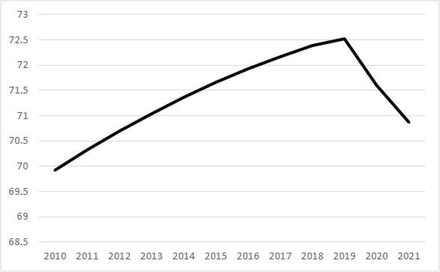((…)) to make ourselves masters and possessors of nature. This is not only to be desired for the invention of an infinite number of artifices, which would enable us to enjoy the fruits of the earth and all the conveniences found therein without any difficulty but principally also for the preservation of health ((…)) if it is possible to find some means that will commonly make men wiser and more skillful than they have hitherto been, I believe that it is in medicine that it must be sought.” René Descartes, philosopher, 1637.
This month’s theme: Longevity and the Digestive System
Introduction
The relationship between longevity and the digestive system is significant, as a healthy gut microbiota, balanced diet, and efficient digestion contribute to overall well-being and lifespan. A diverse gut microbiota supports immune function and reduces chronic inflammation, which is linked to many age-related diseases. Good digestive health prevents conditions like colorectal cancer and ensures efficient nutrient absorption. Additionally, the gut-brain axis shows that a healthy gut can improve mental health, further promoting longevity. Incorporating probiotics and prebiotics can enhance gut health by supporting beneficial bacteria. Thus, maintaining a healthy digestive system through diet, exercise, and stress management is crucial for a longer, healthier life.
Gut Microbiota
Diversity and Balance: A diverse and balanced gut microbiota is crucial for maintaining good health. Studies have shown that people with a wide variety of gut bacteria tend to have a healthier aging process and potentially longer lifespans.
Immune System Interaction: The gut microbiota plays a vital role in the immune system. A healthy gut can help prevent chronic inflammation, which is linked to many age-related diseases.
Research shows that alpha diversity, a measure of microbiota variety, increases with age among normal and successfully aging older adults. This rise in diversity seems to have a positive effect. Beta diversity, which reflects differences in microbial composition between individuals, significantly differs between older and younger adults, and even between the oldest-old and younger-old adults. Although the specific taxonomic composition and functional potential vary across studies, Akkermansia is consistently more abundant in older adults. At the same time, Faecalibacterium, Bacteroidaceae, and Lachnospiraceae are reduced, especially among the oldest-old. Compared to younger adults, older adults exhibit reduced pathways related to carbohydrate metabolism and amino acid synthesis.
However, the oldest-old individuals show increased short-chain fatty acid production and enhanced pathways related to central metabolism, cellular respiration, and vitamin synthesis. Studies have shown that beta diversity significantly changes across different life stages, continuing to diverge even within older age groups. Oldest-old adults with high alpha diversity have greater temporal stability in their microbiota composition. Lower alpha diversity is associated with decreased cognition in aging and is a marker of metabolic and inflammatory diseases. These findings suggest that Akkermansia may support gut homeostasis and healthy aging by reducing inflammation and the risk of metabolic and cognitive disorders.
A fecal microbiota transplant (FMT), also referred to as a stool transplant, involves transferring fecal bacteria and other microbes from a healthy donor to another person. FMT is a proven treatment for Clostridioides difficile infection (CDI). For recurrent CDI, FMT is more effective than vancomycin alone and may enhance outcomes even after the initial infection.
Probiotics and Prebiotics
Probiotics are live microorganisms that provide health benefits when consumed, often found in fermented foods such as yogurt, kimchi, and sauerkraut. They support gut health by introducing beneficial bacteria to the microbiome and reducing the growth of harmful bacteria by occupying their space. Prebiotics are nutrients that promote the development of beneficial gut bacteria, thereby enhancing overall gut health. The primary prebiotics is microbiota-accessible carbohydrates (MACs), commonly known as dietary fiber. Found in fruits, vegetables, whole grains, legumes, and other plant materials, these complex carbohydrates resist digestion and absorption, allowing them to reach the colon intact and feed gut bacteria.
The gut microbiota influences cellular senescence and skin health through the gut-skin axis by secreting microbial metabolites. Metabolomics can help identify and quantify these metabolites involved in senescence. Novel anti-senescent therapeutics are useful. Probiotics and prebiotics may serve as effective alternatives, given their connection to the microbiome and healthy aging. However, the known effects are limited, and further research on gut composition during senescence is needed to develop immunomodulatory therapies.
Inflammation and Aging
An unhealthy gut can cause a “leaky gut,” leading to systemic inflammation and accelerated aging.
The human body encounters potentially toxic and infectious substances daily in the gastrointestinal tract (GIT), which bears the greatest load of antigens. The GIT maintains intestinal integrity by permitting beneficial agents to pass while blocking harmful substances. Normally, a healthy intestinal barrier prevents toxic elements from entering the bloodstream. However, factors like stress, an unhealthy diet, excessive alcohol, antibiotics, and drug consumption can disrupt the intestinal microbiota and compromise the homeostasis of the intestinal barrier, leading to increased intestinal permeability. This condition, known as intestinal hyperpermeability, allows harmful agents to pass through the junctions of the intestinal epithelium into the bloodstream, affecting various organs and systems.
Consequently, leaky gut syndrome and intestinal barrier dysfunction are linked to intestinal diseases such as inflammatory bowel disease and irritable bowel syndrome, as well as extra-intestinal diseases including heart disease, obesity, type 1 diabetes mellitus, and celiac disease. Given the relationship between intestinal permeability and numerous conditions, it is essential to develop effective strategies to prevent or reduce increased intestinal permeability. The impact of dietary nutrients on barrier function is crucial for designing new strategies for patients with leaky gut-related diseases associated with epithelial barrier dysfunction.
Aging of the Digestive System
Age-related changes in gut function have profound effects on the motility of the esophagus, stomach, and colon. Older adults are particularly vulnerable to conditions such as malnutrition, postprandial hypotension, dysphagia, constipation, and fecal incontinence.
Reduced numbers of nerve cells in the myenteric plexus, crucial for digestive absorption, and degeneration of villi, which reduces the surface area of the small intestine, contribute to impaired nutrient absorption. Furthermore, aging impairs the intestinal immune system, including the mucosal layer of the gastrointestinal tract, leading to a higher incidence and severity of infections among older individuals. Defects in the structure and function of the mucosal defense system, a reduction in the capacity to produce protective immunity, and a rise in the frequency of inflammation and oxidative stress are all linked to aging.
Although it can affect people of all ages, gastroesophageal reflux disease, or GERD, is most frequent in older persons. Heartburn and associated symptoms of reflux disease (GERD) are brought on by stomach acid backing up into the esophagus. Reflux can be favored by eating the improper meals, such as fried and fast food, and by eating late at night. Heartburn can result from taking certain drugs, such as blood pressure medications, which are commonly taken by older persons. Gaining weight as you age increases your likelihood of developing GERD and heartburn.
Colorectal Cancer
Cancers concerning the digestive system are not the most current and well-known cancers. However, all cancers related to the digestive are responsible for about one-third of all cancer deaths.
Mental Health
The gut-brain axis shows that a healthy gut can positively influence mental health, reducing depression and anxiety, which are linked to longevity. Disruptions in the gut-brain axis affect intestinal motility and secretion, contribute to visceral hypersensitivity, and lead to cellular alterations of the entero-endocrine and immune systems.
Gastrointestinal diseases, such as irritable bowel syndrome, frequently involve psychological comorbidities linked to changes in the gut microbiome. Furthermore, studies have shown that the makeup of the gut flora may have an impact on the brain development of fetuses and newborns. Not surprisingly, food has also been demonstrated to affect gut microbiota’s effect on cognitive performance.
Conclusion
Almost every day of our life, our body absorbs and transforms a big mass of substances, containing non-edible and often even toxic parts. In many aspects, our digestive system is the strongest part of our body. For example, intestinal Epithelial Cells are replaced approximately every 2 to 5 days which is essential for maintaining the integrity and function of the digestive barrier exposed to harsh digestive enzymes and varying pH levels.
This part of the body can give some ideas to scientists about how to have a more resilient body and better stem cells.
The good news of the month: Repair Biotechnologies developed the Cholesterol Degrading Platform, a safe approach to treating medical conditions that arise due to localized accumulations of excess cholesterol
Repair Biotechnologies has developed LNP-mRNA gene therapy that has shown promising results in preclinical models of atherosclerosis. In the LDLR knockout mouse model, the therapy reduced aortic plaque volume by 17% after six weeks of treatment. Additionally, the APOE knockout mouse model, successfully removed plaque lipids and improved plaque stability.
The therapy operates by eliminating toxic excess free cholesterol in the liver, restoring liver homeostasis, and generating systemic benefits throughout the body. The company is preparing for a series A funding round to pave the way for its first clinical trial in 2026, targeting the rare genetic condition of homozygous familial hypercholesterolemia. There is potential for fast-track approval, which could lead to off-label use for treating severe atherosclerosis in the broader population.
For more information










